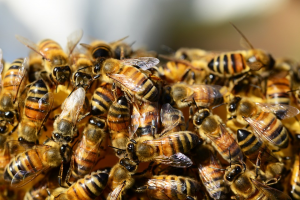Honeybees Build Consensus so Why Can’t We?
May 8, 2017 1 CommentOne of the many things I appreciate about adrienne maree brown’s new book, Emergent Strategy: Shaping Change, Changing Worlds, are the questions she asks over and over again: what are you learning from nature? how does nature inform your organizing and movement building efforts?Autumn Meghan Brown, interviewed in this book, talks about consensus. Building consensus is one of my favorite practices to teach in IISC’s Facilitative Leadership for Social Change workshop. People love consensus and people hate it; I’ve seen many people struggle with when and where consensus is the appropriate decision making method, and with how to facilitate an effective consensus decision making process.

IISC’s Framework: “Levels of Involvement in the Decision Making Process,” above. © 2013 Interaction Institute for Social Change. All rights reserved.
I believe two reasons for this are that we live in a society with an unhealthy relationship to time, and with a low level of skill for collaborative group process. Autumn says these wise things about consensus:
- The history of consensus is deeply rooted in feminist and Indigenous movement work
- Building consensus is the work of collective liberation
- People want consensus to be an antidote to power, but it is not! Consensus does not require equal status; it requires equal voice.
So back to brown’s question, where does consensus happen in nature? What might we learn from nature about consensus?
One of my favorite science writers is Bernd Heinrich. From him, I learned about the incredible way that honeybees reach consensus about where to make their home. Honeybees living in the north temperate region require a home with enough space to: store 25-100 kg of honey (for winter heating fuel) and pollen (to feed baby bees), rear young bees after they hatch from the queen’s eggs, house the total population of tens of thousands of bees. This home must be efficient to heat, which means it can’t be too large or have too large an opening. When a new home site is needed, honeybees make this decision by consensus (unlike other types of bees). A few “scouts” discover potential new home sites and return to tell the other bees about the sites they have found. Each scout does a dance to advertise the unique properties of the site they found. These dancers not only advertise the site they have found, but also attend the dances of the other scouts. As this process goes on, the scouts who’ve found the most superior sites dance longer and more vigorously, attracting more and more converts until all of the bees are dancing together on the same vibration indicating that they have come to a consensus on the best site for their new home. After this decision has been reached, the scouts stop dancing and switch to a “piping” type of vibration that signals the entire swarm of bees to get warmed up and ready to fly to their new home. Is this amazing, or what?!
What can we learn from the honeybees?
- To achieve a true consensus, the queen (translate to…formal leader with the most positional power) need only be one voice (or dancer!) among the many. Her opinion carries no more weight than any other bee’s. However, her commitment to support the swarm’s decision is KEY. The swarm won’t continue the flight to their new home unless her scent is present. They must know that she’s with them.
- What forms of communication might we play with in addition to conversation to get to a consensus? I love visualizing these bees dancing and vibrating their way to consensus. We often over-emphasize spoken communication and large group conversation in our meetings. This privileges extroverted thinkers and the voices of people from historically included groups (men, white people, etc.). How might we make more space for emotion, quiet thinking time, creativity, physical movement? How might we learn to pay more intentional attention to the ways we communicate with one another non-verbally?
- As the bees evaluate the various options for their new home and it becomes clear which site is edging out as the best, the scouts who had previously advertised other possible sites simply stop doing so. They’d been dancing like crazy for that really great hollowed out tree trunk or rock crevice they’d found, but there comes a point when they see the benefits of a site some other bee found and change their dance. We humans could stand to get better at letting go of our egos and attachment to our own ideas when it becomes clear that another way forward is best for the groups we are part of.
- Finally, the bees come to consensus without anyone designated in a facilitator role; that’s a uniquely human need. But what if we could get closer to a reality where many more of us had such a high level of facilitative leadership skill, and were spiritually evolved enough to be free of ego…? Then, maybe we wouldn’t need a facilitator either?!
What other lessons do you see for us in the honeybees story?
To learn more, watch this video to see how a honeybee “waggle dances,” in this case to share information about the location of flowers to pollinate.


1 Comment
The main reason for honeybees consensus is that all honeybees participate, as in the ant colonies. No one ant calls sick and not work. There is no hierarchical structure to tell each ant what to do and they all participate in their daily routines. Even the queen is not in charge. The responsibility is taken to its maximum in the case of the ants and bees. Human being does not want to take responsibility for what they do. They think, higher power will take care of things for them. If you look a the nature, Mother Nature does not have any expectation from anyone. the trees will take Carbon out of the air and gives us the oxygen, the fruit trees gives us fruits without expectation. Why we do not follow these simple rules? I say, there are few people that wants us not to do so and they are in charge.